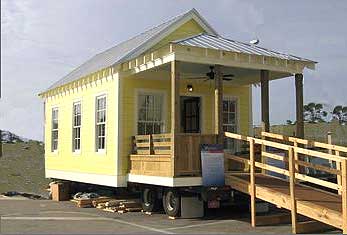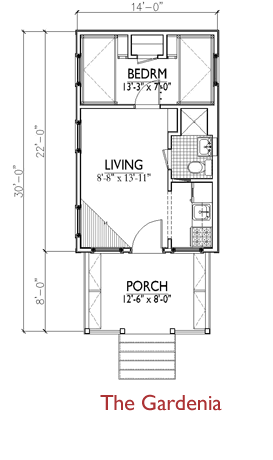Katrina Cottage
A conversation with architect Marianne Cusato
In the fall of 2005, Mississippi Governor Haley Barbour announced a conference on Gulf Coast recovery, called the Mississippi Renewal Forum. Architect Marianne Cusato and her little creation that could, The Katrina Cottage became instantly recognized as an icon for the Charrette or design conference. Everybody loved the Katrina Cottage.



We spoke to Marianne Cusato recently and asked about her firm's involvement with the Recovery Conference, the design criteria and the future of sustainable housing technologies for rebuilding in the storm's aftermath.
A long time associate and protégé of conference organizer Andrés Duany, Cusato was given a design challenge, which at first seemed simple enough, come up with an affordable housing design that would blend with the gulf coast's tradition and style while remaining economically feasible for large scale redevelopment.
Their innovative solution was, at once, both simple and elegant. Taking the standard dimensions of a FEMA trailer, 14 feet by 22 feet or 308 square feet, they designed a single family home similar in style to the traditional "shot gun" house; a straight line structure with gable roof, double hung sash windows in a 6 light over 6 configuration. On the front of the home, to soften the appearance and create a warm, neighborly element she attached an 8' porch. The result is a well-proportioned cottage-like home that immediately evokes images of an old settled southern parish neighborhood filled with families, barking dogs, and tree lined avenues.
"Everyone loved the Cottage," the architect said as if slightly bemused at the thought. The attention Cusato's Katrina Cottage has received in the press has taken her by surprise. She thinks however that her design strikes a cord with folks who want to see their communities and neighborhoods returned to normalcy. The design of the Katrina Cottage does that in many ways, some subtle and some not so subtle but always, very personal. She told us her intention was to meet the conference requirements by building a traditional stick-built, affordable structure - it costs a modest $35,000. They used standard construction methods that would seem familiar to any contractor, and yet would utilize high performance materials such as a long lasting metal roof and "Hardie Board" siding, which reproduces a traditional clapboard appearance. While the use of non-traditional materials virtually eliminates the constant need for expensive, time-consuming maintenance.
However, beyond the exacting design considerations of scale and details like the open rafter tails and front porch rail seating there is a feeling you get from looking at the cottage that it is somehow familiar, as though you had seen it before. Perhaps the home of a favorite aunt or a friend's house you once visited as a child. The front porch beckons and we are all drawn to its human scale and warmth.
The cottage design may be replicated in three traditional styles and can be "re-skinned" with alternative roof styles, windows and other features thus suiting it for different locals and climate conditions. The design is modular as well and may be seamlessly expanded when conditions warrant or even placed on a wheeled frame and moved along streets and highways like a traditional mobile home.
We asked the architect if their decision to build with traditional materials and methods had as much to do with availability and access as with any consideration regarding sustainability. Her answer was simple and direct, "Any good design must also be sustainable or it is no longer good design." Apparently others think that as well the firm has been fielding a steady stream of inquiries regarding the Katrina Cottage, some of them from rather unusual sources. South Main on the River Park, a kayaker's urban initiative in Buena Vista, Colorado wants to build an attractive, sustainable and eco friendly community of homes on the river's edge for wild water enthusiasts. Others are looking at the Katrina Cottage concept for inspiration regarding inner city redevelopment and housing diversification projects.
Architect Cusato was quick to point out that although her design seems to solve some of the conference goals there were a host of other solutions, which were equally innovative and, like the Katrina Cottage, helped to make this Governor's event especially productive.
We'll have a follow up report next month when we take a further look at "good" design and the implications for sustainable, ecologically friendly development practices.
by Harlan Weikle
Greener Magazine
In the fall of 2005, Mississippi Governor Haley Barbour announced a conference on Gulf Coast recovery, called the Mississippi Renewal Forum. Architect Marianne Cusato and her little creation that could, The Katrina Cottage became instantly recognized as an icon for the Charrette or design conference. Everybody loved the Katrina Cottage.



We spoke to Marianne Cusato recently and asked about her firm's involvement with the Recovery Conference, the design criteria and the future of sustainable housing technologies for rebuilding in the storm's aftermath.
A long time associate and protégé of conference organizer Andrés Duany, Cusato was given a design challenge, which at first seemed simple enough, come up with an affordable housing design that would blend with the gulf coast's tradition and style while remaining economically feasible for large scale redevelopment.
Their innovative solution was, at once, both simple and elegant. Taking the standard dimensions of a FEMA trailer, 14 feet by 22 feet or 308 square feet, they designed a single family home similar in style to the traditional "shot gun" house; a straight line structure with gable roof, double hung sash windows in a 6 light over 6 configuration. On the front of the home, to soften the appearance and create a warm, neighborly element she attached an 8' porch. The result is a well-proportioned cottage-like home that immediately evokes images of an old settled southern parish neighborhood filled with families, barking dogs, and tree lined avenues.
"Everyone loved the Cottage," the architect said as if slightly bemused at the thought. The attention Cusato's Katrina Cottage has received in the press has taken her by surprise. She thinks however that her design strikes a cord with folks who want to see their communities and neighborhoods returned to normalcy. The design of the Katrina Cottage does that in many ways, some subtle and some not so subtle but always, very personal. She told us her intention was to meet the conference requirements by building a traditional stick-built, affordable structure - it costs a modest $35,000. They used standard construction methods that would seem familiar to any contractor, and yet would utilize high performance materials such as a long lasting metal roof and "Hardie Board" siding, which reproduces a traditional clapboard appearance. While the use of non-traditional materials virtually eliminates the constant need for expensive, time-consuming maintenance.
However, beyond the exacting design considerations of scale and details like the open rafter tails and front porch rail seating there is a feeling you get from looking at the cottage that it is somehow familiar, as though you had seen it before. Perhaps the home of a favorite aunt or a friend's house you once visited as a child. The front porch beckons and we are all drawn to its human scale and warmth.
The cottage design may be replicated in three traditional styles and can be "re-skinned" with alternative roof styles, windows and other features thus suiting it for different locals and climate conditions. The design is modular as well and may be seamlessly expanded when conditions warrant or even placed on a wheeled frame and moved along streets and highways like a traditional mobile home.
We asked the architect if their decision to build with traditional materials and methods had as much to do with availability and access as with any consideration regarding sustainability. Her answer was simple and direct, "Any good design must also be sustainable or it is no longer good design." Apparently others think that as well the firm has been fielding a steady stream of inquiries regarding the Katrina Cottage, some of them from rather unusual sources. South Main on the River Park, a kayaker's urban initiative in Buena Vista, Colorado wants to build an attractive, sustainable and eco friendly community of homes on the river's edge for wild water enthusiasts. Others are looking at the Katrina Cottage concept for inspiration regarding inner city redevelopment and housing diversification projects.
Architect Cusato was quick to point out that although her design seems to solve some of the conference goals there were a host of other solutions, which were equally innovative and, like the Katrina Cottage, helped to make this Governor's event especially productive.
We'll have a follow up report next month when we take a further look at "good" design and the implications for sustainable, ecologically friendly development practices.
by Harlan Weikle
Greener Magazine



3:18 PM









<< Home